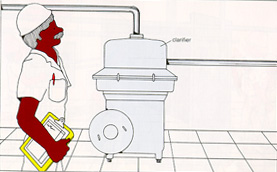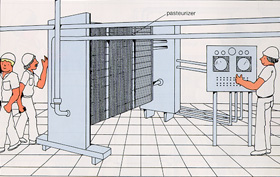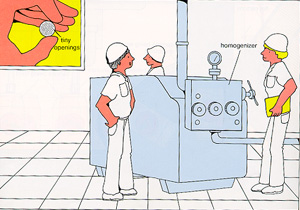Let's Process Milk
 From Milk: From Cow to Carton |
Once the milk has been inspected, it is moved from the tanker and mixed with the rest of the milk supply in a clarifier. Since the milk comes from many different dairy farms, it has different amounts of cream. Therefore, the milk must be blended during a process called standardization until it all contains the same amount of butterfat. |
Now, processing can begin. In the first step, milk is pasteurized which means that it is heated by a series of plates to atleast 163 degrees for 15 seconds and then cooled quickly back down to its normal storing temperature (37-38 degrees). Pasteurization kills any disease-causing bacteria that may be present in the supply and helps to make the milk stay fresher for a longer time period. |

From Milk: From Cow to Carton |
The milk then travels to a separator that separates the butter fat out of the milk and then meters it back in to give the milk the proper amount of fat content. Depending on what type of milk is being processed, the separator adds 3.25% to 0% fat back into the milk. During the next step, milk undergoes a homogenization process in which the milk is forced through tiny openings under high pressure. This breaks down the fatty globules of cream so that the cream will not float on top of the milk, and every drop of milk will contain equal amounts of cream. |
 From Milk: From Cow to Carton |
During processing, vitamins A and D are added to the milk in a step called fortification. Furthermore, tests are run regularly on milk samples in the dairy plant labs that check for its water content, fat percentage, and for the presence of bacteria. The water that is in milk is not added on purpose, but it is water from the machinery that is acidentally mixed into the milk supply. The maximum water content in milk that the government allows is 1.8%. This whole procedure from the standardization of milk to its pasteurization is called processing.
|
 Home
Home

